The strigil (Latin) or stlengis is a tool for the cleansing of the body by scraping off dirt, perspiration, and oil that was applied before bathing in Ancient Greek and Roman cultures. In these cultures the strigil was primarily used by men, specifically male athletes; however, in Etruscan culture there is some evidence of strigils being used by both sexes. The standard design is a curved blade with a handle, all of which is made of metal.
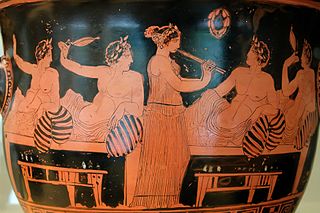
In Ancient Greece, the symposium was a part of a banquet that took place after the meal, when drinking for pleasure was accompanied by music, dancing, recitals, or conversation. Literary works that describe or take place at a symposium include two Socratic dialogues, Plato's Symposium and Xenophon's Symposium, as well as a number of Greek poems such as the elegies of Theognis of Megara. Symposia are depicted in Greek and Etruscan art that shows similar scenes.

The J. Paul Getty Museum, commonly referred to as the Getty, is an art museum in Los Angeles, California housed on two campuses: the Getty Center and Getty Villa.
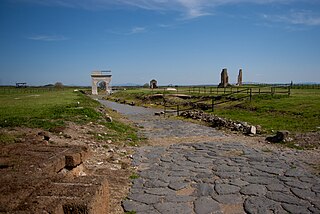
Vulci or Volci was a rich Etruscan city in what is now northern Lazio, central Italy.

The Chimera of Arezzo is regarded as the best example of ancient Etruscan art. The British art historian David Ekserdjian described the sculpture as "one of the most arresting of all animal sculptures and the supreme masterpiece of Etruscan bronze-casting". Made entirely of bronze and measuring 78.5 cm high with a length of 129 cm, it was found alongside a small collection of other bronze statues in Arezzo, an ancient Etruscan and Roman city in Tuscany. The statue was originally part of a larger sculptural group representing a fight between a Chimera and the Greek hero Bellerophon. This sculpture is likely to have been created as a votive offering to the Etruscan god Tinia.

The Sarcophagus of the Spouses is a tomb effigy considered one of the masterpieces of Etruscan art. The Etruscans lived in Italy between two main rivers, the Arno and the Tiber, and were in contact with the Ancient Greeks through trade, mainly during the Orientalizing and Archaic Period. The Etruscans were well known for their terracotta sculptures and funerary art, largely sarcophagi and urns. The sarcophagus is a late sixth-century BCE Etruscan anthropoid sarcophagus that was found at the Banditaccia necropolis in Caere and is now located in the National Etruscan Museum of Villa Giulia, Rome.

Etruscan art was produced by the Etruscan civilization in central Italy between the 10th and 1st centuries BC. From around 750 BC it was heavily influenced by Greek art, which was imported by the Etruscans, but always retained distinct characteristics. Particularly strong in this tradition were figurative sculpture in terracotta, wall-painting and metalworking especially in bronze. Jewellery and engraved gems of high quality were produced.

A klismos or klismos chair is a type of ancient Greek chair, with curved backrest and tapering, outcurved legs.

The Monteleone chariot is an Etruscan chariot dated to c. 530 BC, considered one of the world's great archaeological finds. It was originally uncovered at Monteleone di Spoleto and is currently a major attraction in the collection of the Metropolitan Museum of Art in New York City.

The Tomb of the Leopards is an Etruscan burial chamber so called for the confronted leopards painted above a banquet scene. The tomb is located within the Necropolis of Monterozzi, near Tarquinia, Lazio, Italy, and dates to around 470–450 BC. The painting is one of the best-preserved murals of Tarquinia, and is known for "its lively coloring, and its animated depictions rich with gestures," and is influenced by the Greek-Attic art of the first quarter of the fifth century BC.

A mastos is an ancient Greek drinking vessel shaped like a woman's breast. The type is also called a parabolic cup, and has parallel examples made of glass or silver. Examples are primarily in black-figure or white ground technique, though early examples may be red-figure. A mastos typically has two handles and a "nipple" at the bottom, though some examples have a foot as a base instead. A mastoid cup is conical, but with a flat bottom, with or without handles.
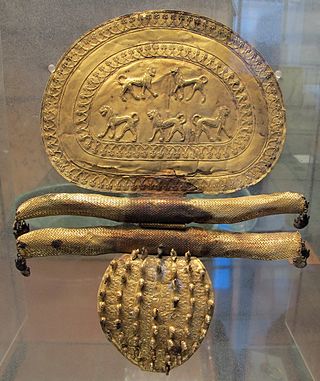
The tomb known as the Regolini-Galassi tomb is one of the wealthiest Etruscan family tombs in Caere, an ancient city in Italy approximately 50–60 kilometres (31–37 mi) north-northwest of Rome. The tomb dates to between 680/675-650 BC. Based on the evidence of the tomb's architecture and its contents, it was built by a wealthy family of Caere. The grave goods included with the two decedents included bronze cauldrons and gold jewellery of Etruscan origin in the Oriental style. The tomb was discovered in 1836 in modern-day Cerveteri in an undisturbed condition and named after the excavators, general Vincenzo Galassi and the archpriest of Cerveteri, Alessandro Regolini. Both of these men had previous experience opening and excavating tombs in the area of Caere.

The Tomb of Hunting and Fishing, formerly known as the Tomb of the Hunter, is an Etruscan tomb in the Necropolis of Monterozzi near Tarquinia, Lazio, Italy. It was discovered in 1873 and has been dated variously to about 530–520 BC, 520 BC, 510 BC or 510–500 BC. Stephan Steingräber calls it "unquestionably one of the most beautiful and original of the Tarquinian tombs from the Late Archaic period." R. Ross Holloway emphasizes the reduction of humans to small figures in a large natural environment. There were no precedents for this in Ancient Greek art or in the Etruscan art it influenced. It was a major development in the history of ancient painting.

The Tomb of the Triclinium ) is an Etruscan tomb in the Necropolis of Monterozzi dated to approximately 470 BC. The tomb is named after the Roman triclinium, a type of formal dining room, which appears in the frescoes of the tomb. It has been described as one of the most famous of all Etruscan tombs.
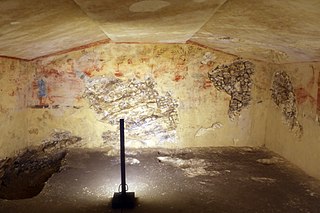
The Tomb of the Blue Demons is an Etruscan tomb in the Necropolis of Monterozzi near Tarquinia, Italy. It was discovered in 1985. The tomb is named after the blue and black-skinned demons which appear in an underworld scene on the right wall. The tomb has been dated to the end of the fifth century BC.

Set of jewelry, also known as the Vulci group is a set of 5th century BCE Etruscan metalwork collection by an unknown jeweler. It is in the collection of the Metropolitan Museum of Art.

Mischief and Repose is an 1895 oil-on-canvas painting by British artist John William Godward. It has been held by the J. Paul Getty Museum in Los Angeles since 1979. Godward painted a second, smaller painting, with a different composition but the same title, in 1909.
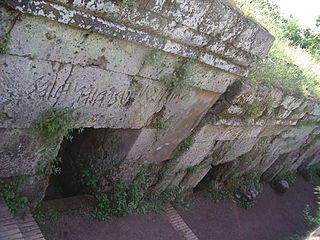
The Crocifisso del Tufo is an Etruscan necropolis in Orvieto, Umbria, Italy.
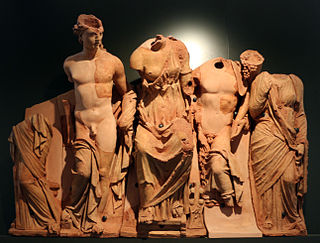
Etruscan sculpture was one of the most important artistic expressions of the Etruscan people, who inhabited the regions of Northern Italy and Central Italy between about the 9th century BC and the 1st century BC. Etruscan art was largely a derivation of Greek art, although developed with many characteristics of its own. Given the almost total lack of Etruscan written documents, a problem compounded by the paucity of information on their language—still largely undeciphered—it is in their art that the keys to the reconstruction of their history are to be found, although Greek and Roman chronicles are also of great help. Like its culture in general, Etruscan sculpture has many obscure aspects for scholars, being the subject of controversy and forcing them to propose their interpretations always tentatively, but the consensus is that it was part of the most important and original legacy of Italian art and even contributed significantly to the initial formation of the artistic traditions of ancient Rome. The view of Etruscan sculpture as a homogeneous whole is erroneous, there being important variations, both regional and temporal.

The status of women in Etruscan society was respected, unlike in Greek and Roman societies. Today we only know of the status of aristocratic women, because no documentation survives about women in other social classes.



















